Our series on American food has included a number of finger foods; we’ve done Chicken Wings, Hamburgers, Chocolate Chip Cookies, and French Fried Potatoes and Sweet Potatoes. But we can’t leave out onion rings.
Ingredients
You’ll need with a batter, made of 4 egg whites, 1 tbsp cream (or milk), and a pinch of paprika, salt, and pepper to taste:
Slice a yellow onion (we like the taste better than sweet onions) and separate it into rings:
Finally, prepare a coating. We like puffed rice, or puffed rice with mixed nuts, ground in a food processor:
Preparation
Place the rings from one onion with 1 tbsp potato starch and salt and pepper in a Ziploc bag:
Shake until the rings are evenly coated. Then dip them in the batter:
And then the coating:
Lay them out on a cookie sheet and bake for 15 minutes at 400ºF (200ºC):
Serve:
Conclusion
They taste great alone or with a dipping sauce: we tried melted butter, ketchup, and our Pacific sweet and sour sauce.







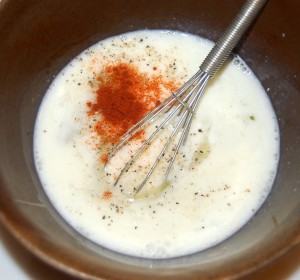
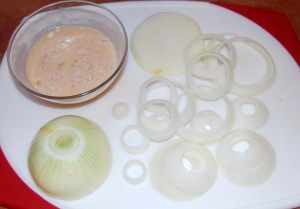
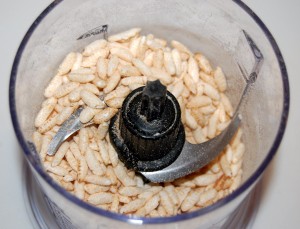
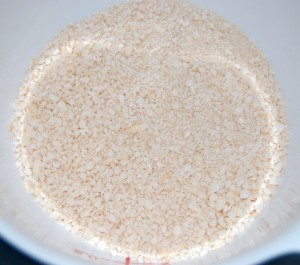


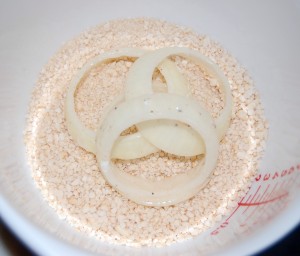
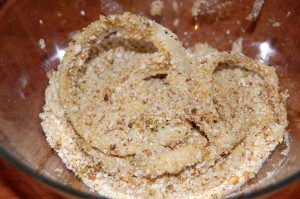
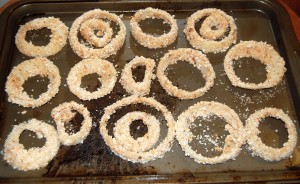
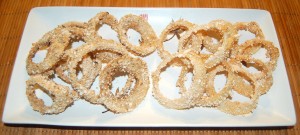




Hrmm some folks (eg Guyenet) have concerns over Maillard reaction browning and blood sugar control. What do you guys think?
Hi Ed,
Definitely gentle cooking to avoid browning is better. We had one batch that came out perfect, another that got a bit overcooked. Unfortunately that one had the picture.
However, the toxins that are produced in Maillard browning (advanced glycation endproducts) are mostly destroyed in digestion. So the biggest danger comes from AGEs created in the body, not AGEs created in cooking.
One reason we oven-cooked these instead of frying them is that oven-cooking probably generates fewer toxins.
So, it’s a good point, and one definitely wants to minimize browning damage, but I don’t think a little bit of browning during cooking is a big deal.
Paul, I have finished reading PHD in the last 3 days and really enjoyed the book. I also enjoy reading your blog and plan on reading all the posts in the next few weeks. I have found them – the book and the blog – both very helpful. Thanks for all the time you put into both. Being Asian who live in the West, I am aware of the health benefits of coconut and it’s a big part of my diet while growing up. I remember my mother has even trained our househelp/chef to always use coconut oil for cooking- stir fry, deep frying, etc. And coconut milk was always used for cooking everything – fish, meat but even vegetables and desserts. And my mom used to tell me that her parents lived long, over a 100, because not only did they use coconut milk in cooking everything but also, that they drink hot chocolate (from ground cocoa beans from the cocoa trees in their backyard). When I left home and went abroad for studies, somehow I have lost the fondness for coconut milk and other food I was familiar with, and have adopted a more ‘foreign’ or should I say a ‘western diet’ and consequently gained weight. After getting married to an Englishman who loves his bread and pudding, I am now out of shape haha! I am 5’6″ and used to be 105 lbs but not 128 lbs (from US size 0, now size 6). And yes, I am having a tough time losing the fat despite working out at the gym cycling or running and doing weight lifting 5-6 days a week. I tried Atkins and couldn’t take it – only lasted 2 days haha! I have read a lot of health and diet books and though I haven’t tried all the diets available out there, your book has helped me a great in understanding more about how to eat ‘healthily’ and to shed off the fat ‘slowly’ but ‘surely’ because I am not after the ‘quick’ fix but for a long term healthy lifestyle. I have already bought virgin coconut oil from WholeFoods (thank goodness London got one already!) and yesterday I have also made coconut oil from scratch. It’s kind of like going back into my ‘roots’ you know, eating coconut oil, coconut milk and coconut flour once again. Tomorrow is the start of a new adventure, an exciting one, as I start eating coconut oil one tablespoon each day. Many thanks to you and your wife for the many years of research you put into the book and for continually sharing with us your knowledge over the internet. By the way, thanks for responding to my email re: my question about diet based on blood type. 🙂
Hi Elna,
Traditional Asian food is very healthy, and Asians kept their traditions into recent times. You’re lucky you have those memories to return to.
It’s a pleasure to help! Let me know how things go.
Best, Paul
Here is a University of Basel PhD in biochemistry on AGEs:
“Does this mean that there are differences between endogenously
formed and dietary AGEs?
Buetler:
Indeed, there are some significant differences. One basic
difference between dietary AGEs and those generated endogenously
is their chemical form. Endogenous AGEs are
generally protein-bound while dietary AGEs are absorbed
as free AGEs or AGEs in short peptides. While the free
AGEs are rapidly cleared by the kidney, the endogenous
protein-bound AGEs require degradation before they can
be excreted. Research has shown that glycation can alter
protein functionality, but glycated proteins are also recognized
as aberrations that are degraded by the proteolytic
systems. Part of the association of increased free AGEs in
diabetic complications can be ascribed to the impaired renal
handling of AGEs in this disease. Furthermore, our own
research has shown that some physiological activities of
AGEs are quite different between free and protein-bound
AGEs.
MNF:
Are there any differences in biological effects between dietary
and endogenous AGEs?
Buetler:
There are only limited toxicity data available for dietary
AGEs. But a major problem is that adequate toxicology
studies have not been performed so far. AGEs are a very
heterogeneous class of chemicals and we don’t even know
what the most relevant AGEs to be tested are. On top of
that, we have very little information on the bioavailability
of AGEs to assess the exposure to individual AGEs. The
only information on the toxicity of endogenous, proteinbound
AGEs comes from cellular assays that are of very
limited usefulness to assess their in vivo toxicity.
Also, it should not be forgotten that certain dietary AGEs
also possess beneficial properties such as antioxidant capacity
or the ability to induce cellular defence systems.
…
MNF:
Besides receptor-mediated processes, are there other
mechanisms that could explain the biological effects of
AGEs?
Buetler:
It is important to stress that the toxicity of AGEs is unproven.
AGEs probably have fewother effects as they are
rather unreactive. However, if one considers that AGEs are
formed from reactive precursors under the influence of oxidative
stress, perhaps the focus should be shifted to these.
The dicarbonyl intermediates are very reactive and are
formed from breakdown products of the Maillard reaction
but also from side products of glycolysis and from lipid peroxidation.
These compounds have the potential to modify
cellular proteins that could lead to alterations in their function
that could ultimately lead to a disruption of cellular
homeostasis.
…
And finally, it should be noted that tests should also include
AGE-related molecules, such as advanced lipoxidation
end-products or ALEs. These are similar to AGEs and some
AGEs are formed both during lipid peroxidation and from
the Maillard reaction. CML is a good example of this. What
has been said for the AGEs also applies for the ALEs, i. e.
they are end-products and as such relatively unreactive.
And as for AGEs, their importance probably lies in the formation
and reactivity of the precursors. And again as for
AGEs, lipid peroxidation only occurs in the presence of oxidative
stress. Thus, by reducing oxidative stress, both lipid
peroxidation and formation of AGEs/ALEs can be attenuated
resulting in host protection where diet plays an important
role.
…
Although AGEs/ALEs are present in the diet, I strongly
believe that dietary AGEs are of little health concern. Moreover,
the presence of dietary antioxidants most likely largely
outweighs the potential minor influence these compounds
may have on human health. Thus, although we are
constantly exposed to AGEs, ALEs and their precursors, we
should not worry too much about them. As long as we eat a
balanced diet, we ingest large amounts of antioxidant power
to fight against oxidative stress, the reactive intermediates
and their toxicity. After all, we have lived well with AGEs/
ALEs for many thousands of years.” from http://is.gd/TSngGS ‘AGE interview.pdf’
–
But what do you make of these ALEs and arachidonic acid?
http://inhumanexperiment.blogspot.com/2009/10/fats-and-ages-pufas-are-even-worse-than.html
Hi Lance,
Thanks much for an excellent contribution.
I would generally agree that ALEs are worse than AGEs, that PUFAs are worse than fructose although they are worst together, that endogenously produced products in the body are worse than exogenously produced ones that may be broken down in digestion, and that reactive intermediates may be worse than endproducts. However endproducts may be a good index of past toxic exposure. Gentle cooking and low PUFA oils are generally desirable.
Also from DrGreger’s (a vegan, not vegetarian) PDFs re: AGEs and microflora:
“Sugars
may oxidise to dicarbonyls, e.g. glyoxal and methylglyoxal
which are particularly reactive towards arginine residues in
protein to form hydroimidazolones. When a reducing sugar
reacts with the epsilon amino group of lysine, a reaction
intermediate, known as an Amadori rearrangement product
(ARP) is formed. ARPs are pre-AGEs and when the initial
reducing sugar is glucose, the ARP is known as fructoselysine
(FL). ARPs are unstable reaction intermediates that
degrade to AGEs, including those reported to be the most
abundant representatives in food, i.e. Ne-(carboxymethyl)-
lysine (CML) and pyrraline [2]. AGEs comprise a diverse
group of compounds and the structures of l20 have been
elucidated to date. So far, most research on AGEs have
been directed to their effects in vivo, where they are associated
with the complications of diabetes, especially renal,
retinal and cardiovascular disease [3].”
…
“Up to 80% of dietary ARPs are not absorbed but are
degraded by the gut microflora.”
from http://is.gd/TSngGS ‘AGE con.pdf’
Thanks, Lance.
Looks like DrGreger does think eating AGEs Glycotoxins are major biologically active toxins
http://www.youtube.com/watch?v=vU-DiCUZCxA&list=PL53AA35449C7DD652&index=63&feature=plpp_video&hd=1#t=7m and in uncooked animal foods like cheeses too
But…aren’t there issues with extruded grains like puffed rice?
http://www.westonaprice.org/modern-foods/dirty-secrets-of-the-food-processing-industry
Hi Michelle,
Yes, so they’re to be used sparingly.
Actually there is a traditionally puffed rice that you can buy online. The heat it in a pan filled with hot salt or something like that and it puffs up like popcorn. I don’t remember the traditional name for it but it is easily found online.
Where do you guys get your puffed rice? Maybe what brand? Thanks!!! I’ve been dying for onion rings.
Hi Paul,
I’ve been using your diet protocol for awhile now to heal my gut and have developed rashes due to fermented foods, then chicken, then pork, then avocado, etc. etc. which is very disappointing as I had hoped my food sensitivities would improve once I began eating healthy.
A neuropath at my local health food store has kept prodding me to try the Eat Right 4 Your Blood Type diet for just 10 days to see if it helps my rash, so I have been on it for several days . I haven’t added any foods that strayed from your diet, but I did stop eating the foods that the diet saId were “bad” for my blood type I.e. chicken,pork, avacodo, coconut oil 🙁 , etc. and guess what? My rash is going away. I’m still unsure about eating foods based on blood type.
I did a search on your comments and and you stated that type O blood type diet was ok but not the others. Since I am B positive blood type, I was wondering if you could address your concerns a little more in depth about the blood type B part of the diet.
I really trust your opinion when it comes to these matters ,and I appreciate your time.
I love your diet and want to get rid of my sensitivities so I can eat even the healthy foods without reacting to them. ;(
Kip